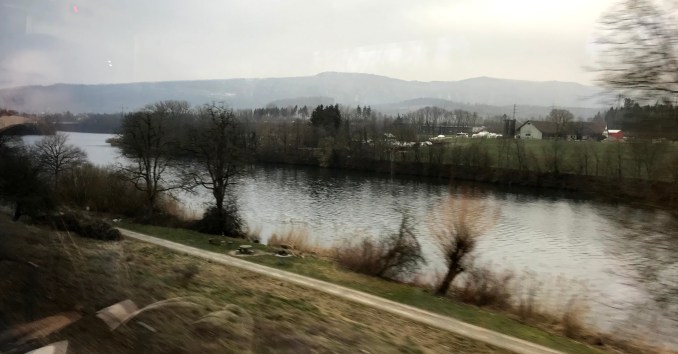
River Aare from the train window
I left my sleeping family at home and headed out without breakfast in the freezing cold to catch the 7 AM train, enthusiastic about the prospect of visiting a nuclear waste repository. I’ve written about nuclear waste at length, and I thought it only right that I should also go and learn about its storage first-hand.
Surprise VIP ride
The centre I was headed to has the capacity to store all expected spent nuclear fuel and lower levels of radioactive waste that has and will be produced by the existing Swiss nuclear plants. It’s called ZWILAG (for ZWIschenLAGer, or interim storage), and it’s located on the northern Swiss countryside in the folds of the river Aare. I was very glad when I received the invitation to join the excursion organised by “Kettenreaktion” (Chain Reaction), a Swiss society for people in support of nuclear energy technologies. Big thanks to them!

Not only did they organise a special access visit to the ZWILAG, but Dr Hans-Rudolf Lutz, a doctor in nuclear physics, and no less than the original director of the Swiss nuclear plant Mühleberg (in operation since 1972), as well as the founder of the society Kettenreaktion, graciously picked me up from the nearest train station and drove me to and from the site himself. On the way there I also learned that Dr Lutz had been responsible for the planning and building of the ZWILAG facility, the very place we were going to be touring. What a privileged ride for me!

Nostalgia
My German was stretched to its limits from my eagerness to get to pick his brain on questions of energy. I learned many interesting things, from current nightly Swiss imports of coal energy from Germany (which he said has coincided with the past weeks of Switzerland being grayed out in the Electricitymap view – the import data can still be found on Germany’s side), to Dr Lutz’s colourful autumn holiday to Italy in the 80’s, in a house powered only by rooftop solar. I also made the observation that here was a man who believes in lasting technology: he was very happy to still be driving his black old Audi, with an actual cassette player. Haven’t seen that in a while!
He was understandably very sad about the recent decision to close the plant which he had helped get on its feet, and which he says could easily have stayed in operation for longer. The Mühleberg power plant is scheduled for an early closure in 2019 due to “uncertainty surrounding political and regulatory trends,” after the Swiss have voted to exit nuclear power entirely by 2034. You can read more about the decommissioning in World Nuclear News.
Friendly but strict welcome at the ZWILAG
 Dr Lutz’s other project – the ZWILAG – however, is not going anywhere. It’s an active center of research into ways of decontaminating and storing radioactive waste.
Dr Lutz’s other project – the ZWILAG – however, is not going anywhere. It’s an active center of research into ways of decontaminating and storing radioactive waste.
There were several interesting insights I gained during the visit. Firstly, the security is as tight as that of a nuclear plant, including the part about scans and protective clothing required to visit the reactor room, though in this case, it is entry into areas with high level nuclear waste that is most heavily guarded – never mind that the spent fuel is already stored snugly inside multi-layered steel casks, classified both storage- and transport-safe.

No photos past this point
This meant no phones (I’ll have to use their official brochure material for photos, UPDATE: these photos at SwissInfo are excellent), or any other possessions apart from clothes – no devices of any kind that weren’t hearing aids or pacemakers. Which included… my new and shiny Geiger counter! It was a birthday present from my husband less than two weeks earlier, and I had very enthusiastically hooked it up with an Android, ready to map and track my radiation exposure during the tour.
No such luck. My Geiger counter spent the tour in the locker-room in the entrance, recording a steady 0.1 µSv/h (in other words, 0.1 microsieverts per hour. The average global natural background radiation level is about 0.2 µSv/h).
Safety first, second, and… once more for good measure
I was one of some twenty guests – most others were retirement-aged Swiss men, several of them nuclear professionals. We were all scanned and checked in with our visitor badges, then shown to the auditorium. After an introductory speech and video, the first group (which I was in, naturally) was taken directly to the heart of the place: the cask storage hall.
 I say directly, but what I really mean was: we were lead through a labyrinth of underground corridors that reminded me of hospital cellars, where automated transporter robots were moving yellow barrels, and taken to changing rooms. We were given yellow socks to wear on top of our own, we left our shoes and put on white galoshes as well as lab coats (new Swiss german word unlocked: kittel) and helmets. Apparently one tall guest had once bumped their head to one particular low ceiling. Now everyone must wear helmets at all times. They take their safety… seriously.
I say directly, but what I really mean was: we were lead through a labyrinth of underground corridors that reminded me of hospital cellars, where automated transporter robots were moving yellow barrels, and taken to changing rooms. We were given yellow socks to wear on top of our own, we left our shoes and put on white galoshes as well as lab coats (new Swiss german word unlocked: kittel) and helmets. Apparently one tall guest had once bumped their head to one particular low ceiling. Now everyone must wear helmets at all times. They take their safety… seriously.
After that we were scanned and badged in yet again, and taken outside the cask hall, where we had to leave our lab coats, and do a peculiar dance with our footwear, all to eliminate any potential movement of contamination: standing in a yellow rectangle on the floor, we needed to pick up a set of clean, comically large slippers – sort of surgical-cap -like flexible-bottomed protection for your feet – and put them on top of our galoshes. We needed to do this without landing the slippered-galoshed foot back in the yellow square, but over a warning-rope and into a small fenced area near the door. Repeat for the other foot. Voila. Don warm coats from the rack, and finally the arm-thick door was opened for us.
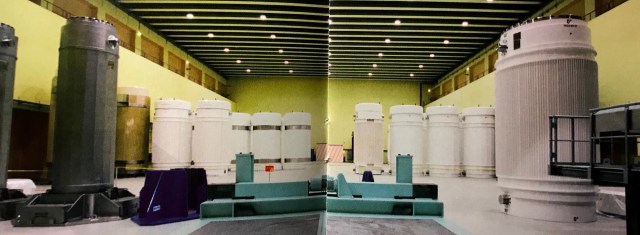
Zwilag brochure photo of the cask hall. They had accumulated a few more, but the view that awaited us was very similar. The grey casks in the left are transport-casks from Mühleberg plant, and their contents will eventually be moved over to the white type.
Patting the waste under IAEA’s watchful eye
The air in the hall was cool, the big crane beam in the ceiling was a nice shade of violet, and the walls were painted in soft yellow. A few meters from the door was a black-and-yellow plastic line across the room with a sign: “HIGH RADIATION AREA No unnecessary stay !!!”

This sign sparked my next blog piece on the evidence of what kind of levels of radiation have been found to be harmful.
Ours, clearly, was necessary ^_^
What also was necessary, was to have our visit reported beforehand to the authorities – the International Atomic Energy Agency (IAEA) was watching. There were cameras with a live video feed delivered directly to IAEA from two corners of the hall. I waved.
Next we got to cross the ominous line (this motivated me to write another piece, for a discussion about what kind of risk a stay in a ‘high radiation area’ actually entails) and actually go and feel the casks which contain the spent nuclear fuel. The child in me was thrilled! Our guides pointed out to us the differences between an old cask (cold to the touch), a bit newer ones (about normal room temperature), and a freshly arrived one (hot like a nicely pumped-up radiator). They explained the passive cooling ventilation in the room (hence the warm coats for us) designed to lead away the waste heat from the casks, and presented schematics of the structure and double-pressurised safety mechanism of the containers.
An inner hull of the container is filled with helium at low pressure (slight vacuum), and sealed. The next hull is filled with helium at a high pressure and equipped with a pressure sensor. Should any crack appear in between the hulls, the outer pressurised helium would leak into the under-pressurised core and the change in pressure would be detected immediately.
Without an actual physical leak, alpha and beta radiation (helium nuclei and electrons) can’t escape the cask, and the protective layers in place greatly reduce neutrons and gamma radiation (high energy photons).

Brochure on cross sections of two different types of casks.
Forbidden low-carbon energy source
The guides pointed out to us two casks that stood out, one blue and one red, explaining that they held the remains of the fuel that had at first been sent for reprocessing, with the aim to be used again as nuclear fuel to free a greater degree of the uranium’s inherent energy into the grid as carbon-free electricity. But the Swiss laws had put a stop to this.
The roomful of valuable uranium before me, still containing more than 90% of its energy, was dictated to stay there in the cellar, and later in a deep repository, its energy to remain untapped indefinitely. This made me very sad, knowing that while all this carbon-free energy sits there unused, imports of coal energy from Germany are given a free pass above-ground every night.
I can only hope that accurate information about nuclear power will spread, and politicians will come to their senses about the importance of acting to mitigate climate change before too late.
Melting waste by lightning
Apart from spent nuclear fuel, the ZWILAG also receives low and intermediate level radioactive waste, both from the nuclear energy sector and nuclear medicine. The waste streams are considerably much lower in volume than many quite toxic wastes from most other parts of chemical or energy industries, but a lot of money is spent on figuring optimal ways to dispose of them.
For a general description, Wikipedia has a good summary. Basically, low level waste includes everything from office materials to clothing that has even a remote possibility of contamination, and intermediate level wastes are materials that are contaminated to a degree that warrants some type of shielding.
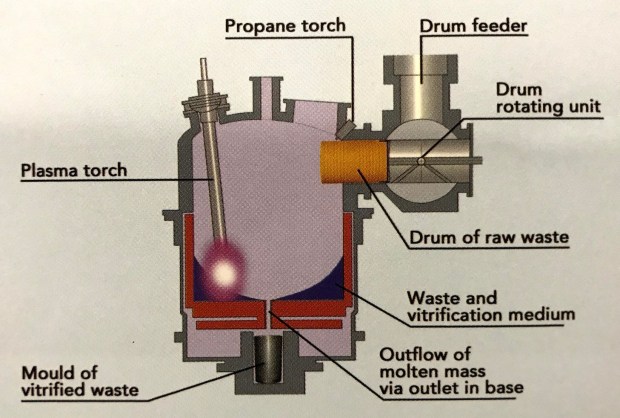
Plasma oven schematic
Interestingly, the ZWILAG has a high tech solution to concentrating intermediate level radioactive waste – resulting in a reduction of volume and an increase in radioactivity by about a factor five. This is done in a plasma oven, where any manner of radioactive materials, including metal and concrete, can be melted down with the help of a 1200 kW standing lightning generating several thousand degrees of heat. Mixed together with scrap glass, the molten mass drains and vitrifies into a canister-sized cylinder of waste, ready to be canned and stored.
What is and isn’t radioactive waste?
They also experiment with a number of ways of cleaning superficially contaminated equipment and materials from radiation, optimally to be released as ‘no longer radioactive waste’. The methods are anything from very high-pressure wash (powerful enough to cut through limbs), to ultrasound or acid baths, to mechanical abrasion with power tools. What I saw of the materials awaiting conditioning, there were some pieces of tarpaulin, air filters, and different kinds of metal frames or old pieces of metal structures. To be released as ‘clean’, these materials would have to measure at 0.1 µSv/h.
Let that sink in. For a material that has in some way been associated with nuclear energy to be considered safe for release as regular waste, it has to demonstrate radiation values lower than the natural worldwide average background of 0.2 µSv/h. Most of the world, in other words, would not meet those ‘clean’ requirements. In fact,
the granite countertop I use to prepare food on in my kitchen would never get ‘clean’ enough to be released from nuclear waste storage.
There is nothing abnormal about my countertop – granite often contains traces of radioactive elements. Despite that, if my block of granite had been used in connection to a nuclear plant, it would for ever have to remain safely stored and monitored behind multiple seals, awaiting burial in a deep geological repository, where it would be left, in conditions that would guarantee its safe retainment for the unforeseeable future.
Ironically, it could be ‘safely separated’ from the environment and the general population by… tons and tons more of naturally radioactive granite.

It appears that the same levels of radiation are rendered somehow ‘dangerous’ merely from the mental association to nuclear energy, and not the actual physical characteristics of the objects.
There are many such examples that demonstrate the irrational nature of common attitudes toward radiation and nuclear power. To name a few: the Japanese officials won’t release perfectly safe water from holding tanks out of fear, not of radiation, but of the impact on public image – read about that in the excellent report from Mothers for Nuclear on their recent trip to Fukushima. Another example is how Greenpeace thinks radiation that is normal for people living in Finland should elsewhere merit an evacuation. It seems to me that it is the association, rather than the levels, or the actual size of the risk, that deems whether the thought of radiation causes an outrage.

My Geiger counter and ZWILAG swag. Very punny to hand out bag-clips and waterproof wallets with their motto “Sicher verschlossen”, securely enclosed. The nuclear shill chocolate they gave out at Gösgen power plant remains unbeaten, however!
For the employees of the ZWILAG, in any case, the nuclear waste poses no concern. Their annual occupational exposure is just 0.3 mSv in average – a very small addition the global annual average dose of 2.4 mSv, especially considering that sizeable populations in the world are exposed to 10-20 mSv naturally.
And our tour, including the visit to the ‘high radiation area’? According to the dosimeter, we gained a whooping 2 µSv (0.002 mSv) over the course of about two hours. The ZWILAG is making good of its promise to shield people from excess radiation, keeping nuclear waste Sicher verschlossen, securely enclosed or safely locked up, as their motto reads.
But all the safety measures in the world may not be enough to set everyone’s mind at ease, when it comes to nuclear waste. One older example of this fear of radiation surfaced when our tour was over, and we were having lunch with the members of the Kettenreaktion association at a nearby Swiss village.

Greenpeace protesters and banners hanging from the crane at the ZWILAG site in the year 2000
At the restaurant, Dr Lutz passed around a newspaper from the time the ZWILAG was first opened (featuring articles written by two people present!). It also had a photo of Greenpeace protesting the building project some 18 years earlier.
It left me scratching my head. Greenpeace were against the building of a storage site for nuclear waste? What would they have preferred – not to build one?
I, for one, welcome the idea of an industry that fully assumes responsibility of the handling of all of its waste indefinitely. I wish other technology sectors would follow suit. That would be far better an alternative than leaving the inevitable waste streams of harmful materials to their own fate, ending up on scrap yards or land-fills, or up in the atmosphere in the form of smoke, carbon dioxide, and particulate pollution.

For more articles on nuclear power and radiation, you can find my pieces under Climate and Energy.
If you would like to have a discussion in the comments below, please take note of my Commenting policy. In a nutshell:
- Be respectful.
- Back up your claims with evidence.

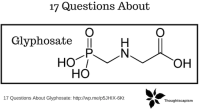
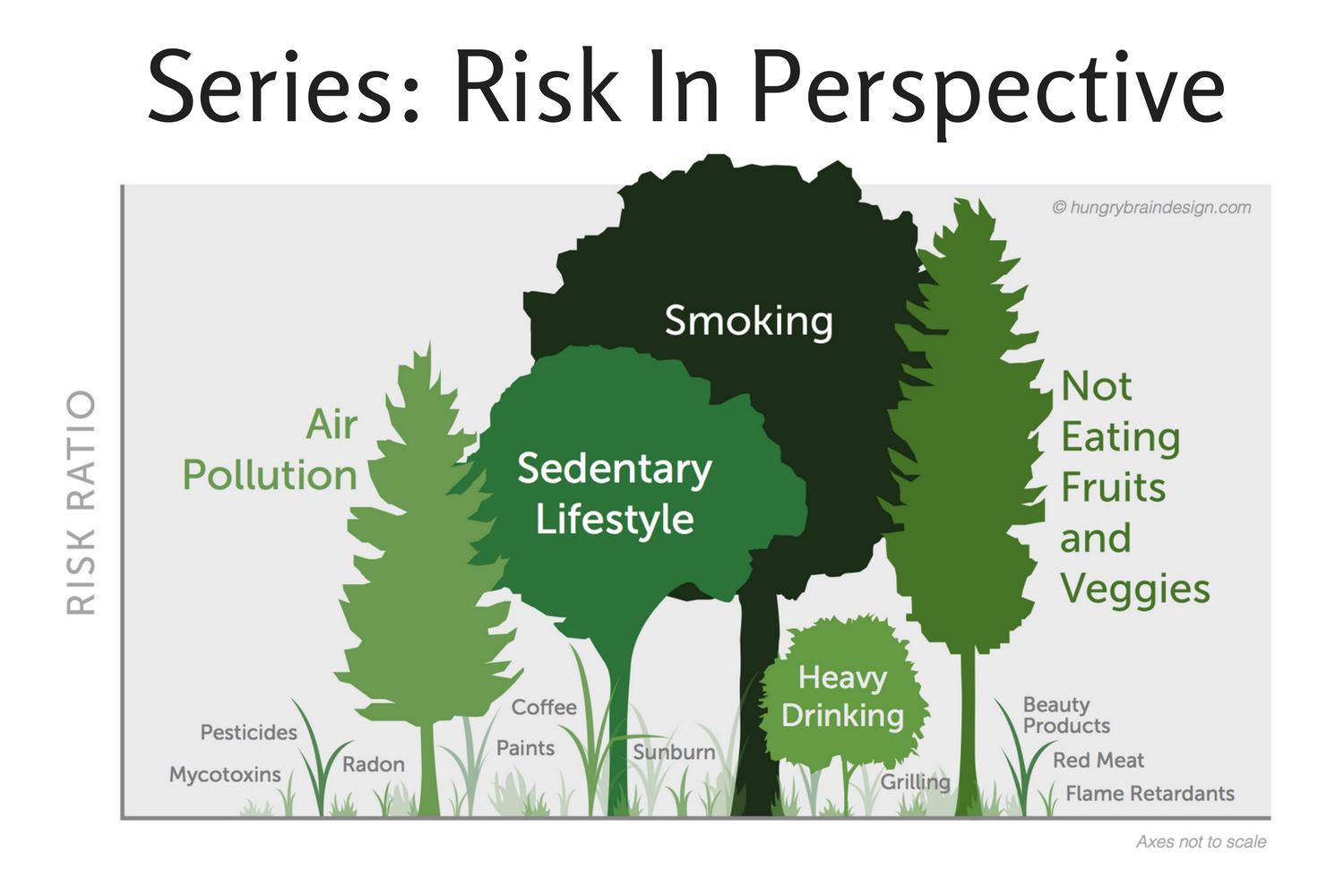
Great report. Thanks!
Well for one, radioactive coal wastes would fill a repository in short order!
LikeLiked by 1 person
Very good piece. Thanks for helping to provide a rational perspective. Your point about a typical granite countertop being fit for a DGR, but only if associated with “nuclear” was a good one.
It reminded me of a trip to our nearby nuclear power plant. We toured the area where spent fuel was stored in casks, felt the warmth being given off as you did and in the end the largest radiation dose we received was in the walk across the parking wet from rain. The radon from the aggregate in the pavement gave our shoes a much higher dose than the trip through the waste handling and storage facilities.
I realized then that a trip to Walmart on a rainy day was likely to provide a much higher dose of radiation than we will ever see from spent nuclear fuel facilities.
LikeLiked by 1 person
I work at a nuclear waste management facility, and radon drives us nuts because, on humid and rainy days, it will trip our radiation portals and prevent us from leaving the facility until it off-gasses. Haha
LikeLiked by 1 person
Pingback: Nuclear Waste: Ideas vs Reality | Thoughtscapism
Pingback: Radiation and Cancer Risk – What Do We Know? | Thoughtscapism
Hi there! This was an interesting article. But I think you should have included the fact that the radiation in your countertop is different from the radiation in nuclear waste. In rock it is “solid” and in the waste it is not. From nuclear waste you can get it to your body by simply wiping it. That does not apply to the countertop. This is something that came up when I shared your text on Facebook. A friend of mine (who works with radioactive materials) pointed this out. English isn’t my native language and I don’t know much about this MYSELF so please take that in consideration when reading. 🙂 Thanks.
LikeLiked by 1 person
Hello Kalle!
Thanks for your comment. You are quite right to point out that different forms of radioactive materials can pose very different types of risks, inhaled radioactive dust or gas could potentially be much more harmful, for instance. I suppose there would be a possibility that the surface-decontaminated objects could give off some of their radioactive particles, but considering the treatments they go through in the attempt to decontaminate them (stuff like superhighpressure wash, mechanized grinding/sanding, ultrasound or acid baths, etc) most of those materials would probably not wear off more particles very easily.
I could have answered you in what I guess is your native language, but your english seems excellent to me, and for the benefit of other readers, I’ll continue in english 🙂
Thanks for reading and sharing! Please don’t hesitate to share any further insights from your friend with a professional perspective into this.
Iida/Thoughtscapism
LikeLike
Hi Kalle. Good point, as this is often brought up in similar discussions. The issue of ingestion of radionuclides is thoroughly discussed in Wade Allison’s second book ‘Nuclear is for Life’, and once understood, one realizes it is not such a special case as one often sees it presented.
First one has to realize human beings are already necessarily radioactive in our natural state, by an average amount of about 100 Bq/kg, due to decay of potassium 40, which has a radioactivity that is very comparable to that of cesium.
On page 102 and further, Allison explains the consequence of adding to this radioactivity by ingestion of cesium in amounts that were present in the aftermath of the Fukushima accident. Although I would encourage you to read the chapter, and with a spoiler alert, I reveal Allison’s conclusion: the cesium was no big deal. Quite a small deal, actually. That is: unless you have been made to believe that there is no safe amount of radiation. In that case, earth is a dangerous place indeed! The positions in this debate I’ve tried to sketch elsewhere in these comments.
LikeLike
Excellent report! It will come as no surprise that your discoveries are consistent with what I’ve learned during my visit to the Dutch nuclear waste repository in the Netherlands, COVRA. There they told me the maximum allowed extra dose for workers at the facility is 40 µSv/year. That happened to be the extra dose I got from a 10 day vacation in Bayern, in the south of Germany, where the hills are exactly as radioactive as your kitchen countertop.
I’m in the process of unraveling the state of the ‘debate’ on the assumed danger of low dose radiation. Until recently, I thought there were three basic position one could have in this controversy, and it would be useful to put these in a diagram, but I can’t do that here, so I’ll try to sketch it. At the extremes, the positions are
a) the belief that LNT describes reality and hence, no safe dose exists. The presence of low dose radiation allows the calculation of collective doses that inevitably lead to deaths, out of which death counts can be stated. This is the position usually held by antinuclear groups. Even the ICRP, whose rule is behind the absurdities you describe, has explicitly stated that such death counts are an abuse of LNT. At the other extreme is
c) the belief that LNT is false, falsified and should be abolished. Doses of up to 100mSv/year are no problem at all. This is the position of Wade Allison and other SARI-scientists, and they have been supporting their claim with solid arguments, based not only in statistics but more importantly in recent insights in cell biology. Their main point: living tissue does not respond passively to radiation, it has numerous ways to take care of what is a process that is really ‘business as usual’.
The third is position is between a and c, hence
b) which is the view that is implemented by ICRP, that states that LNT should be the basis of radiation safety rules. This is the widely held position within the nuclear sector. It states that LNT may not be a description of reality (although the rule leaves room for this interpretation) but is simply a way to keep on the safe side. In combination with ALARA, one gets the draconic ‘safety measures’ (others can’t help seeing this as a staged performance) that you and I have been witnessing. As your readers know, the experience at Fukushima has brought to light the big tradeoff of this position: in case of mishap, nobody will understand or believe experts that say ‘don’t panic, these rules only exist to keep on the safe side, the rule has no basis in reality’.
I’ve discovered there actually is a fourth position,
d) held by some more enlightened experts within the nuclear sector. This position states that doses of up to 10mSv are nothing to worry about. This belief leaves no room for fictional death counts and clearly states that such counts are an abuse of the rule. Although scientific evidence delivers strong support for c), the advantage of the c) is that the sector may be able to embrace it in due time. One has to understand that in the present situation, probably a majority of workers in the nuclear sector have jobs that are based on the b) position. Resistance to moving from b) to c) may be colossal. Moving from b) to d) may be more feasible. During an interview I had with a radiation expert within the sector that held position d) (but who does not want to be quoted on this) he told me a shift from b) to d) would save the sector billions in each country with a nuclear sector.
LikeLiked by 1 person
hm, under d) the second c) should be a d) (sorry, couldn’t find an ‘edit’ button’
LikeLike
Thanks for this very interesting and enlightening report.
LikeLike
Thanks for reading and commenting!
LikeLike
Pingback: Radiation Exposures at a Glance | Thoughtscapism
“…At Harwell in the 1950s the newly-crowned Queen Elizabeth was handed a lump of plutonium in a plastic bag and invited to feel how warm it was…”
https://www.neimagazine.com/opinion/opinionthe-drama-of-plutonium
LikeLike